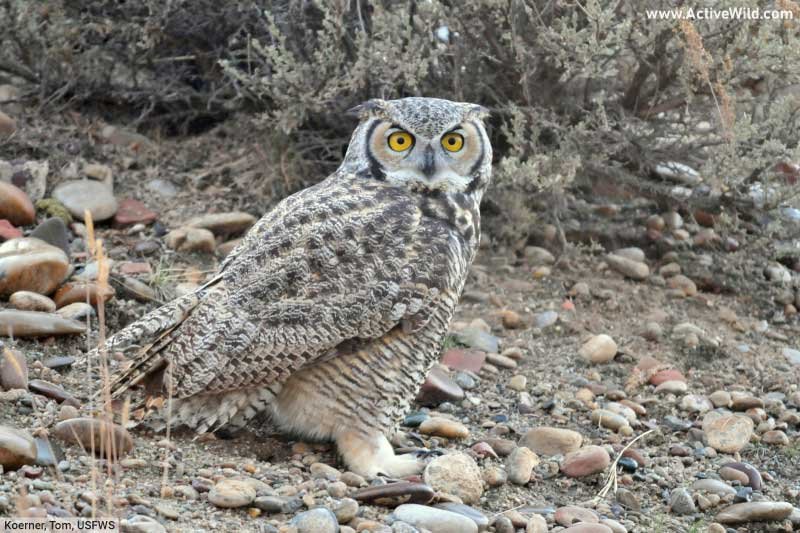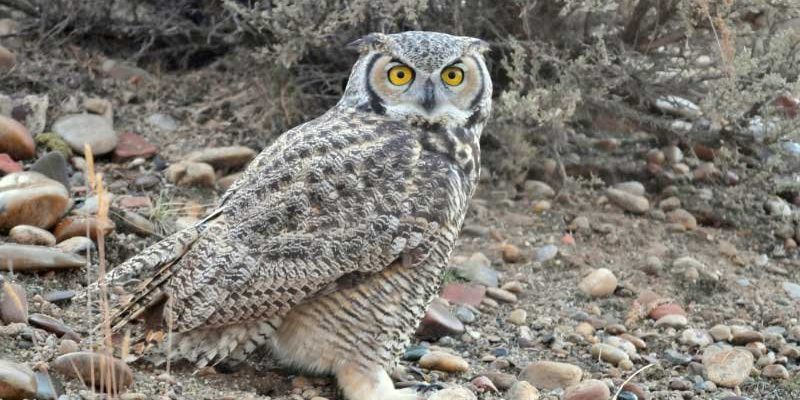
Imagine sitting quietly in a forest, the dim light filtering through the trees as dusk settles in. Suddenly, you hear a low hoot echoing through the woods. That could very well be a Great Horned Owl calling to its mate! These birds are not just nocturnal hunters; they are widespread across North America and have a fascinating range that spans many different environments. Let’s dive into the places where you’re most likely to spot these incredible birds.
Understanding the Great Horned Owl’s Habitat
Great Horned Owls are known for being adaptable. This means you can find them in a variety of habitats, from dense forests to urban areas. They’re true survivors, able to make themselves at home in many settings.
Forests are one of their primary habitats. They prefer areas with plenty of trees, where they can nest and hunt for prey. These owls often select large, old trees—like oaks or conifers—because they provide excellent nesting sites. Look for these majestic birds perched on sturdy branches, letting the world go by as they scan for anything that moves below.
You might also find them in grasslands and scrublands. Interestingly, they can thrive in open spaces, making them versatile hunters. Their strong hunting skills allow them to catch rabbits, rodents, and even birds, no matter where they are. So, if you’re hiking through a grassland area, keep your eyes peeled—these adaptive hunters could be just out of sight!
North America: A Great Horned Owl Paradise
In North America, Great Horned Owls are one of the most common owl species. They’re found from Canada all the way to the southern parts of South America. Think about it: from the snow-covered regions of the north to the deserts of the southwest, these owls have a diverse range.
Let’s break it down by region:
- Canada: Here, you’ll find Great Horned Owls in almost every province. They thrive in boreal forests, which provide plenty of nesting sites and hunting opportunities.
- The United States: These owls inhabit a range of environments, including forests, deserts, and even urban areas. You might catch a glimpse of one perched on a streetlight in cities!
- Mexico: In the southern regions, Great Horned Owls continue to adapt, nesting in both rural and urban settings.
When scouting for these owls, consider visiting local parks or wildlife reserves. Many of these places offer the right mix of trees and open spaces that make them ideal hunting grounds.
Spotting Great Horned Owls in Urban Areas
Believe it or not, Great Horned Owls often adapt to urban life! You might be wondering how they manage this. Well, cities provide a unique blend of hunting grounds and nesting sites. Tall buildings can mimic natural cliff faces where these birds like to roost.
In urban areas, they often hunt for small mammals and birds that thrive in human habitats. Parks, golf courses, and even neighborhoods can be great spots to look for them. Just keep an eye out for trees in these areas—the more mature the tree, the better your chances!
Interestingly, Great Horned Owls are less shy than other types of owls, so don’t be surprised if you find one in your backyard. Just be sure to observe quietly. Catching them in action can be thrilling!
Western Expanses: The Rocky Mountains and Beyond
Moving west, the Rocky Mountains are another fantastic area to observe Great Horned Owls. These majestic birds often make their homes in the rugged terrain and dense forests of the Rockies. The high elevation and diverse ecosystems provide ample hunting opportunities.
In these mountainous regions, they nest in cliffs and tall trees, taking advantage of the elevation to survey the land below. If you’re hiking in areas like Rocky Mountain National Park, look and listen carefully. You might hear their distinctive hoot echoing through the valleys as night falls.
Another great spot in the west is the Pacific Northwest, where lush forests and abundant wildlife create an ideal environment for these owls. The combination of thick timberland and open spaces means there’s plenty of room for hunting and nesting.
Great Horned Owls in the Southern States
As you travel toward the southern U.S., the presence of Great Horned Owls remains strong. In states like Texas and Florida, these birds thrive in a range of habitats, including marshes, forests, and prairies.
In Texas, the wide-open plains and thorny thickets provide great hunting grounds. When exploring areas like the Big Bend National Park, you’re likely to encounter these owls perched on fence posts or hunting in the dusk.
Florida, on the other hand, offers a blend of wetland and forest. Great Horned Owls often nest in the tall cypress trees along the swamps. If you visit areas like the Everglades, listening for their calls can enhance your wildlife experience.
Great Horned Owls’ Range Extending Beyond North America
While North America boasts plenty of Great Horned Owls, their range extends to parts of Central and South America too. These owls can adjust to various ecosystems, from tropical forests to semi-arid regions.
In Central America, you’ll find them in places like Guatemala and Costa Rica, where they thrive in both lowland forests and mountainous terrains. As you move further south, Great Horned Owls continue to adapt. In regions like Argentina, their ability to hunt in diverse habitats means they maintain a healthy population throughout the continent.
Finding spots to observe them in these regions might not be as straightforward—often, it’s about exploring less-traveled paths and seeking out nature reserves.
Best Practices for Spotting Great Horned Owls
Now that you know where to find these magnificent birds, let’s talk about how to increase your chances of spotting them. Here are some tips for successful owl watching:
1. Timing is Key: Great Horned Owls are primarily nocturnal. Early evening and just before dawn are the best times to seek them out.
2. Listen for Their Calls: Familiarizing yourself with their distinctive hoots can help you locate them. Once you hear that deep “hoo-hoo,” you’re on the right track!
3. Bring Binoculars: A good pair of binoculars can help you spot them in the trees or across open fields. Look for movement or the outline of those iconic tufts.
4. Stay Quiet and Patient: Owls can be skittish, so minimizing noise is crucial. Patience is key; sometimes, you may have to wait in silence for a while.
5. Join Owl-Spotting Groups: Many communities have local birdwatching groups. Joining one can enhance your experience and help you learn even more.
Finding Great Horned Owls can be a rewarding experience. With the right approach, you can enjoy these fantastic creatures in their natural habitat.
Great Horned Owls are truly remarkable birds with a wide range of habitats and a fascinating adaptability that allows them to thrive in both wild and urban settings. As you venture out in search of these magnificent creatures, remember to appreciate the beauty of their environments too. From the dense forests of North America to the urban landscapes where they’ve made a home, Great Horned Owls are waiting to be discovered.
So grab your binoculars, soak in the sights and sounds of nature, and who knows? You might just catch a glimpse of these wise old hunters as they glide silently into the night. Happy birdwatching!

